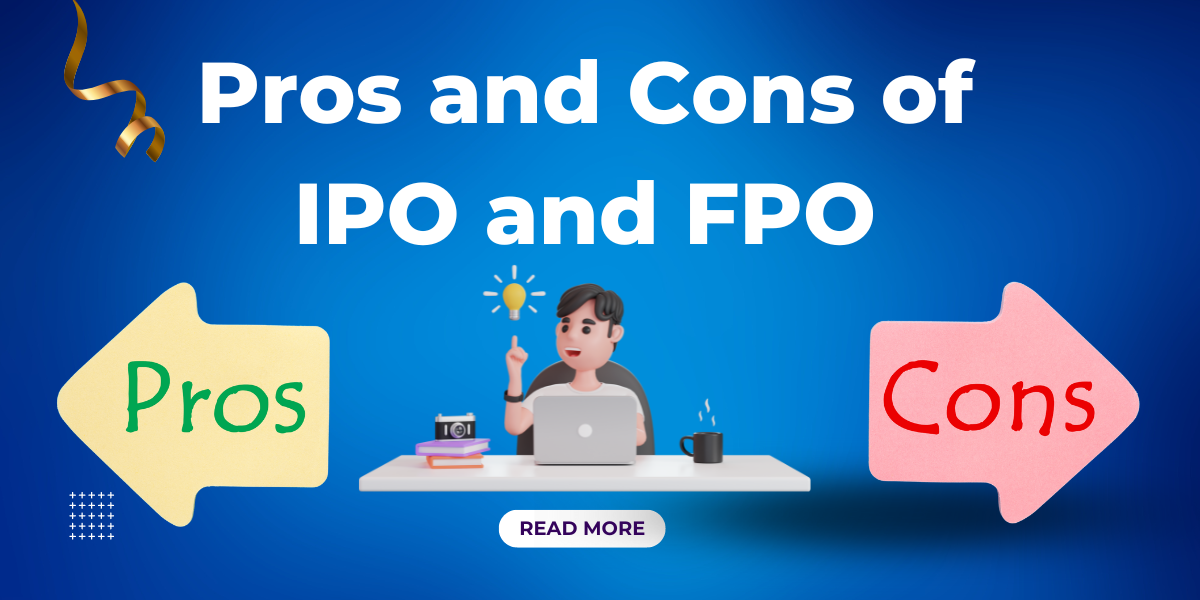Are you considering investing in the stock market? If so, you’ve likely come across two common terms: IPO and FPO. In this blog post, we’ll explore the Pros and Cons of IPO and FPO, and we’ll also clarify the key differences between these two investment options.
What is IPO and FPO?
Before we dive into the pros and cons, let’s start with the basics. IPO stands for Initial Public Offering, while FPO stands for Follow-On Public Offering. These are two distinct ways for companies to raise capital by selling shares to the public.
Now that we’ve clarified the full forms and basic concepts let’s weigh the pros and cons of each.
Pros of IPO:
1. Capital Infusion:
- An IPO can provide a significant influx of capital to fuel growth and expansion plans.
2. Liquidity for Investors:
- It allows early investors and employees to cash out their shares, providing liquidity.
3. Enhanced Credibility:
- Going public can enhance a company’s reputation and credibility in the market.
4. Access to Public Markets:
- It enables access to public markets, making it easier to attract institutional investors.
Cons of IPO:
1. Costly and Time-Consuming:
- IPOs involve substantial costs and require significant time and effort in regulatory compliance and documentation.
2. Loss of Control:
- Going public may dilute the ownership stake of existing shareholders, leading to a loss of control for founders.
3. Intense Scrutiny:
- Publicly traded companies face increased scrutiny from shareholders and regulatory bodies.
4. Market Volatility:
- Share prices can be volatile post-IPO, which may impact the company’s reputation.
Pros of FPO:
1. Additional Capital:
- FPOs allow companies to raise more capital without the complexities of an IPO.
2. Existing Market Presence:
- Companies conducting FPOs already have a presence in the stock market.
3. Lower Costs:
- FPOs typically involve lower costs and less regulatory burden compared to IPOs.
Cons of FPO:
1. Market Conditions Matter:
- The success of an FPO can be influenced by market conditions and the company’s financial performance.
2. Potential Dilution:
- Existing shareholders may experience dilution as new shares are issued.
3. Investor Sentiment:
- The market’s perception of the company can impact the success of an FPO.
Difference between IPO and FPO
| Aspect | IPO (Initial Public Offering) | FPO (Follow-On Public Offering) |
|---|---|---|
| Full Form | Initial Public Offering | Follow-On Public Offering |
| Occurs When | A private company goes public for the first time | A public company issues more shares to the public |
| Purpose | Raise substantial capital for growth and expansion | Raise capital for various purposes (e.g., debt reduction, acquisitions) |
| Regulatory Complexity | Generally more complex and expensive | Typically involves lower regulatory burden and costs |
| Existing Market Presence | Company is new to the stock market | Company is already listed on a stock exchange |
| Timing | Usually an early stage in a company’s lifecycle | Can occur at any stage of a company’s lifecycle |
| Dilution of Ownership | May lead to dilution of ownership for founders | Existing shareholders may experience dilution |
| Market Conditions Impact | Market conditions play a significant role | Impact of market sentiment is still relevant |
Conclusion
Both IPO and FPO have their advantages and drawbacks. The choice between them depends on a company’s financial needs, market conditions, and long-term goals. As an investor, understanding these pros and cons is crucial for making informed decisions in the dynamic world of finance. Whether you’re considering an Initial Public Offering or a Follow-On Public Offering, it’s essential to assess the risks and benefits carefully
If you found this article helpful, please share it with others who might be interested in understanding the world of IPO and FPO. Happy investing!
Connect, Learn, and Grow Through Binaryfinance
